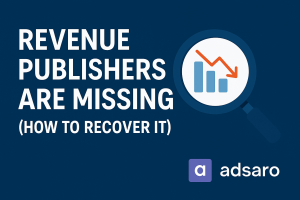Just a few years ago, Web3 advertising was being touted as the future of digital marketing — a decentralized, transparent, and user-empowering alternative to traditional ad models. Fueled by the broader movement around blockchain and crypto, it promised to reshape how data, attention, and value were exchanged in the digital ecosystem. Headlines called it the death knell of centralized ad tech. But as we step further into 2025, many in the industry are asking: What happened? Is Web3 advertising still relevant?
In this blog, we’ll unpack the current state of Web3 advertising, analyze what’s working (and what’s not), and offer insights into how decentralized marketing and blockchain advertising are evolving as part of the broader future of ad tech.
The Rise of Web3 Advertising: A Quick Recap
To understand where we are today, we need to look back. Web3 advertising emerged in response to growing concerns about data privacy, user consent, and the dominance of big tech in digital advertising. At its core, it aimed to decentralize control, allowing users to own their data, earn rewards for engagement, and interact with brands on their terms.
Platforms like Brave, which rewarded users in cryptocurrency for viewing ads, and decentralized ad networks like AdEx and MadNetwork, were at the forefront. These platforms used blockchain advertising principles to offer transparency, reduce fraud, and eliminate intermediaries.
For a time, the concept gained real momentum. It attracted privacy-conscious users, crypto enthusiasts, and forward-thinking brands. But building a truly decentralized advertising ecosystem proved to be more complicated than it seemed.
Web3 Advertising Current Landscape and Use Cases
Fast forward to 2025, and Web3 advertising is no longer a buzzword — it’s a niche but established element of the digital marketing world. While it hasn’t taken over the industry, it hasn’t disappeared either. In fact, several use cases have proven to be resilient and even promising:
Reward-based ad models are still thriving on privacy-first platforms. Users can opt in to view ads and receive tokens or crypto in return. This value exchange model empowers users and helps brands build stronger relationships.
Blockchain verification for ad delivery is being used to enhance transparency and combat ad fraud. Some DSPs and SSPs now offer on-chain verification features to ensure that impressions are valid, not faked by bots.
Smart contracts are automating payments and licensing fees for content creators and advertisers. This removes the need for manual invoicing and reduces the risk of payment disputes.
NFTs in loyalty and branding are being experimented with by brands looking to build unique engagement experiences. Though still experimental, this use of decentralized marketing tools helps brands deepen their connections with niche audiences.
These examples show that Web3 advertising is evolving. It may not be mainstream, but it’s definitely still “a thing.”
What’s Holding Web3 Advertising Back?
Despite some real-world traction, several challenges continue to hinder Web3 advertising from widespread adoption.
Scalability is perhaps the biggest roadblock. Traditional blockchain networks can’t yet handle the volume and speed of ad transactions required in real-time bidding (RTB). Processing thousands of requests per second — as is typical in programmatic environments — is simply too much for most decentralized systems today.
User adoption is another hurdle. For Web3 advertising to work as intended, users must be comfortable with crypto wallets, tokens, and permission layers. While the crypto-savvy crowd is growing, it’s still a fraction of the general internet population.
Regulatory uncertainty also looms large. As different governments craft legislation around digital assets, data sharing, and crypto, brands are cautious. They worry about the legal implications of rewarding users with tokens or using smart contracts tied to real-world assets.
These barriers mean that while blockchain advertising has a place in today’s ecosystem, it still operates on the fringe rather than the core.
Why Web3 Advertising Didn’t Go Mainstream (Yet)
So, why didn’t Web3 advertising completely take off? The answer lies in its foundational challenge: it tried to replace rather than augment the existing ad tech stack.
The current centralized ad ecosystem — with giants like Google, Meta, and Amazon — is well-oiled, measurable, and scalable. It supports granular targeting, audience insights, and real-time campaign optimization. While Web3 offers benefits like user privacy and transparency, it hasn’t yet matched the performance, scale, or simplicity of existing solutions.
Rather than an all-out revolution, Web3 is slowly becoming an evolution — one that may eventually work alongside traditional systems instead of against them.
Emerging Hybrid Models: The Best of Both Worlds
Interestingly, hybrid models that combine traditional ad tech with decentralized marketing principles are gaining momentum in 2025.
Some demand-side platforms are exploring blockchain integrations for impression tracking or smart contract-based payments. These tools help reduce fraud and improve trust without overhauling the entire system.
Publishers are offering tokenized loyalty programs to reward users for content engagement or ad interactions — no blockchain expertise needed on the user side.
Ad tech companies are beginning to incorporate zero-knowledge proofs to offer targeted ads without compromising user privacy — an innovation rooted in Web3 philosophy.
This hybrid evolution suggests that Web3 advertising still has a future — just not the one initially imagined. Instead of a complete disruption, it’s shaping up to be a complementary force in the future of ad tech.
Conclusion
In 2025, Web3 advertising is alive, evolving, and finding its niche. It’s no longer seen as a “silver bullet” for fixing digital advertising’s flaws, but it is proving valuable in areas like transparency, fraud prevention, and user rewards.
As the infrastructure improves and user adoption grows, we may see decentralized marketing solutions take on a larger role — especially as concerns around privacy and data ethics continue to rise. For now, though, Web3 remains a promising sidecar to the dominant models of today.
Smart publishers and advertisers are watching closely, experimenting where it makes sense, and preparing for a future where blockchain advertising isn’t the only solution — but definitely part of the solution.








Leave a Reply